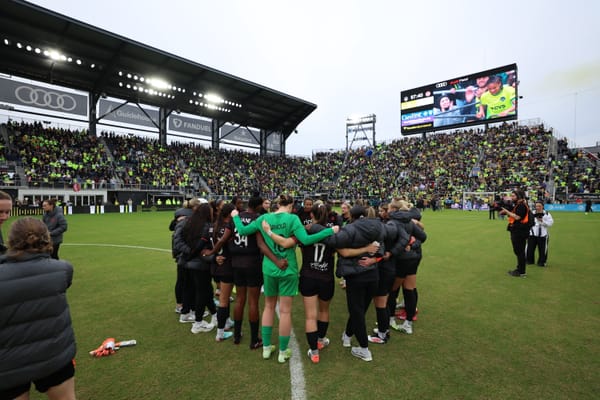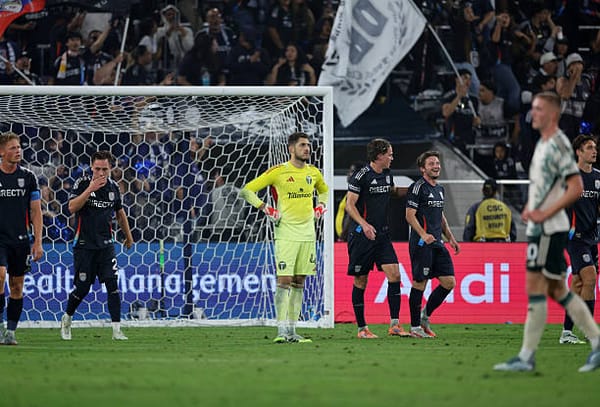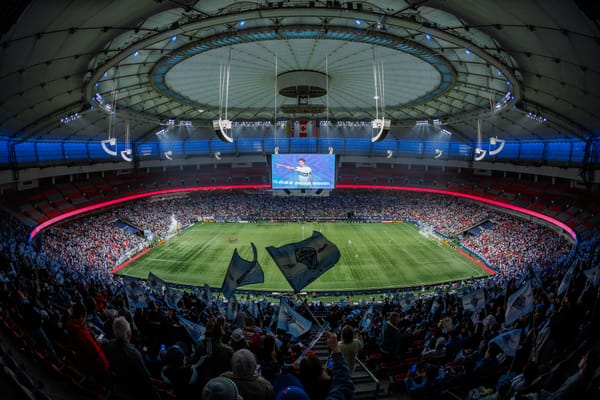The 2025 Offseason To-Do List: Part 1 (The Present and Future)

It has been 12 days since Portland’s season ended in humiliating fashion at Snapdragon Stadium. In that span, the entire MLS world has been flipped upside down.
The Calendar Change
I didn’t expect it to happen. But it did nonetheless. Beginning in 2027, Major League Soccer will shift from a February-to-December schedule. The new season will take place from July to May.
In order to make this possible, a winter break from mid-December to February will be added. The regular season will end in April, and playoffs will take place in May. 2026 will be the last year with a traditional MLS season taking place.
2027 will begin with a “sprint season” occurring from February to May. The regular season will consist of 14 games, and MLS Cup will be in May. Once that “sprint season” has ended, the new calendar will begin.
I think MLS dropped the ball by not instituting this change in 2026. The World Cup provided a natural reason for the calendar break to occur. But that’s a minor nit-pick. This is a good thing!
There are three major “flashpoints” for discourse surrounding this decision. So let’s take a look at them.
Weather
Gaining more cold-weather games in exchange for warm-weather games isn’t a popular decision. Clubs like Minnesota, Toronto, Montreal, and Chicago will be disproportionately affected by having to play more games in winter. However, I think there’s a fair bit of overreaction here.

This is how the 2027/28 schedule overlaps with 2025. The biggest gulf is in June and July. However, this is better for the league and the players. I’d gladly take a colder game over a warmer game. Losing warm summer nights is very tough, but you’re also losing Texas sweat-fests throughout the summer. That’s a gain rather than a loss. It’s easier for players to play in winter because they’re constantly moving and staying warm. In addition, having summers off for fans and players is a positive.
The 2026 schedule has already been released, and here’s how it compares to 2027/28.
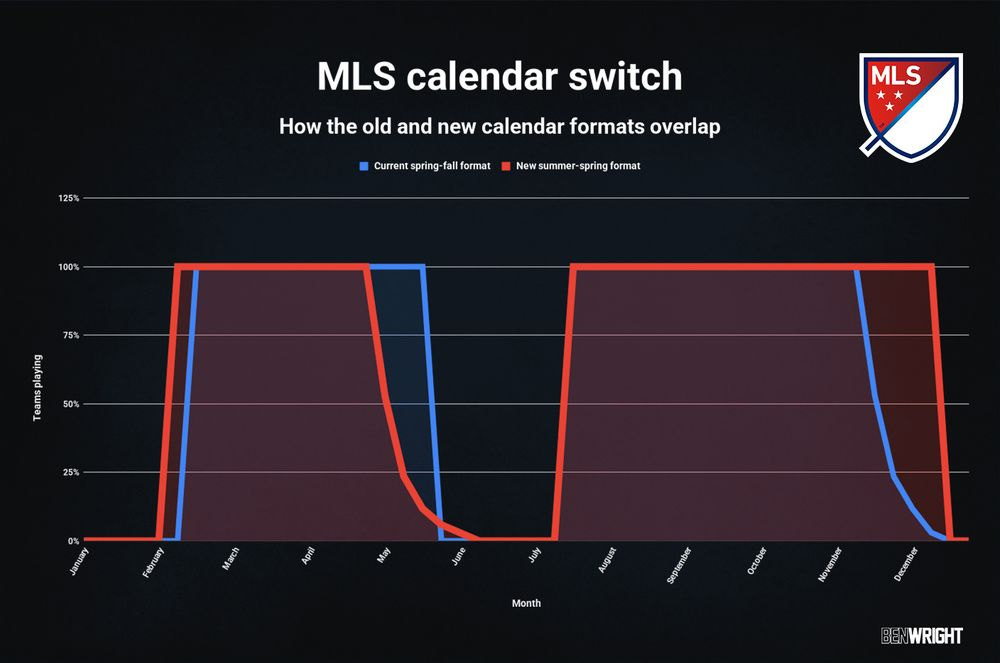
Because of the World Cup break next year, 2026 will be a close mirror to the new format. The only difference is when the season actually begins.
European Calendar
The biggest positive to this calendar change is the ability to make the transfer windows align. It will be easier to sell and buy players from Europe. Consequently, those transfer windows will not align with South America anymore.
International breaks will no longer occur at the most important time of the year. Playoffs aren’t going to be impacted (like they currently are) by an international break. This is a humongous win.
Table Switch
The regular season format will also change.

The implied change is five divisions of six teams. Teams would play their “division rivals” twice (home and away) and every other team once. Hypothetical divisions have been floated, and I think there’s only one way to make it work.
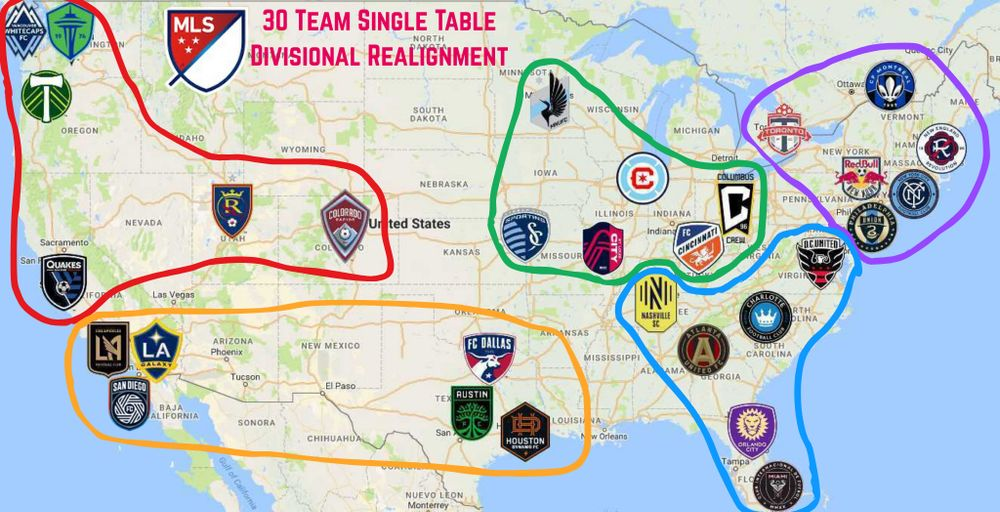
It can’t look like anything other than this. One division will have to occur across three timezones. This alignment makes the most sense. Period.
My Honest Take
When this news broke last week, my immediate reaction was geared towards surprise. Not due to the actual change, but the fact that it was agreed upon by the Board of Governors. I wish this decision was announced at the end of the year instead of early November. On the whole, my reaction to all of this is actually rather lukewarm.
I’m much more concerned with the minutia of the roster rules than I am about a calendar switch. This is a big step towards helping MLS grow in global stature, and it will help domestically with the playoffs no longer aligning with college football and the NFL. But as someone who wants to see MLS become the best version of itself (because it benefits the Timbers), there are bigger issues to tackle. Changing the calendar is something that was going to happen eventually. It isn’t ground-breaking news that it finally happened. However, if/when transfer fees are no longer factored into a player’s cap hit, I’d be metaphorically foaming at the mouth with excitement.
I’m very interested to see how the non-league competitions (Open Cup, CCL, and Leagues Cup) will be impacted by this change. All three of them should be able to continue, but I think Leagues Cup gets nerfed to a significant degree. I’m also in favor of CCL taking place in the second half of the season and getting all the high-stakes games in a single area of the calendar.
This switch will help the league, but there’s still more to do. I’m very excited for the 2027 “sprint season” and the chaos it will bring (the Timbers are absolutely winning it, by the way). I’m happy that a new era is beginning, but I don’t have “deal-breaking” issues with the current format either. On the whole, my reaction can be quantified with a single word: “Eh.” I’m happy about it, don’t get me wrong, but I’m not over the moon about it because I expected it to happen eventually.
2026 Schedule Release
In other news, Portland’s 2026 schedule has been released.

The season begins on February 21st and ends on November 7th. That’s an earlier start and a later finish than 2025. Between May 23rd and July 16th, there won’t be a Timbers game due to the World Cup. There are 6 Eastern Conference games on the schedule: Columbus home, Montreal away, Miami away, Chicago away, Atlanta home, and Charlotte home. That’s four playoff teams and two others that I expect to be massively improved from poor 2025 seasons.
Portland will be finished with their Cascadia Cup games by August 1st. They play Vancouver twice in their first six games before facing Seattle twice in the span of sixteen days. One game in particular is rather infuriating.
The Timbers’ annual trip to Seattle is on Thursday, July 16th. It’s the first Timbers game after the World Cup break. I think it’s beyond stupid to schedule such an important rivalry game on a Thursday.
This is not an easy schedule by any means, and the beginning of the season is particularly treacherous.
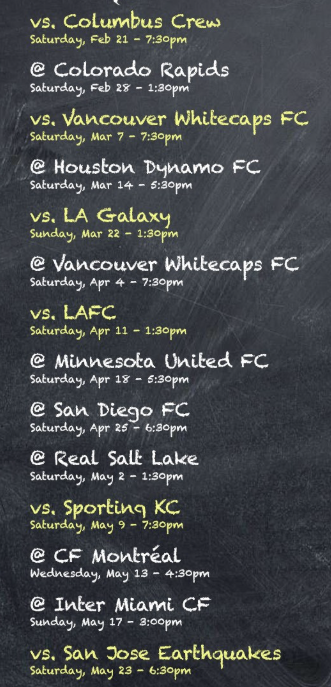
These are all of Portland’s games before the World Cup break. 8 out of 14 are away from home. This includes a nearly month-long gap between games at Providence Park. But I don’t see any (particularly) troublesome travel gaps in this stretch. The Montreal-Miami week will probably necessitate an extended stay in the Eastern Time Zone, but there’s a full three day rest between each game in that week.
The majority of home kickoff times are at 7:30 PM, except for both LA games (1:30 PM) and the regular-season home finale against Houston (6:00 PM). I wish there were more 6 PMs scattered in amongst those 7:30s. I’m not going to entertain Leagues Cup or Open Cup possibilities until Portland’s qualifications for those tournaments have been confirmed. Based on the process used in 2025, I think the Timbers will be in both tournaments.
7 games will be “midweek” matches, and 6 of them will occur after the World Cup. The Timbers won’t see St. Louis or Austin until the second half of the season. However, their season series with Vancouver will conclude at the start of April. Portland will have three consecutive home games twice, and they will have three consecutive road games twice.
This is a difficult schedule. When a new schedule drops, I always look for the places for the team to find momentum. As of right now, I’m struggling to see how momentum can be found prior to the World Cup. But I do like how their season ends. 3 out of their final 5 are at home. Their best momentum launchpad is from July 16-September 12, with 7 out of 12 games at Providence Park.
These schedules aren’t always optimal, but you have to play the games. Now that all the future nonsense is out of the way, it’s time to return to the present.
Roster Decisions
Let’s begin with the departed. Two players definitely won’t return, while the future of others is still (proverbially) up in the air.
The Declined Options/Free Agents
Cristhian Paredes will not be back in Portland next year. He’s been perpetually underrated throughout his time as a Timber, and it’s going to be weird without him on the roster. However, with a salary cap hit that exceeded his squad status (playing time and production) it made sense to not pick up his contract option. He was the second-longest tenured Timber (8 full seasons) at the end of 2025. Between his contributions on the field (I maintain that the Timbers would’ve triumphed in the 2021 MLS Cup if he started the game) and his presence in the locker room (many players have credited him with helping them adjust to Portland and the team) he leaves the team with a good legacy in Green-and-Gold.
Maxime Crepeau is another confirmed departure. His acquisition in January 2024 looked like a coup, but he wasn’t able to hang on to the starting job. With the World Cup around the corner, he needs to find a place where he’s the unquestioned starter. His tenure was plagued by inconsistency, but I believe that this fanbase has treated him terribly. On his day, he’s still a match-winning goalkeeper. The Timbers were treated to that on several occasions; most notably during their 1-0 victory at LAFC in 2025. Like Paredes, his cap hit outweighed his production, and it was the right move to allow him to enter free agency and find a new club.
Felipe Carballo and Matias Rojas didn’t have their contract options picked up. The Timbers are still a fan of Carballo, who will need a fair amount of time to recover from a torn ACL. Rojas was bright during several of his appearances, but he couldn’t stay healthy down the stretch. I don’t have an issue with either of these decisions.
I’d be OK with bringing Eric Miller back on another Senior Minimum Salary contract, but I understand allowing him to enter free agency. The Timbers are close to finalizing a new contract with academy goalkeeper Hunter Sulte, who will compete for the backup job behind James Pantemis.
Dario Zuparic’s future is the most cloudy. He’s going to enter free agency, but it’s possible for the Timbers to bring him back on a cheaper contract than his current $907K salary. He’s going to turn 34 in 2026. There’s a world where he signs with the Timbers for somewhere between $300-400K, which would still be a good deal in my book. If Zuparic’s last game in Portland has already been played, he’s left behind an excellent legacy.
A cult hero in the truest of terms, the Croatian center back’s sharp wit and warrior mentality brought the Timbers to cup finals in each of his first two seasons. In the first one (MLS is Back), he scored his first goal for the club. Through blood, crunching tackles, and a willingness to launch the ball forward, he’s a no-nonsense defender in a game that is starting to move away from that archetype. A Balkan behemoth who will never stop trying to leave his mark on a game. He will be missed if this is the end of his time in Portland.
The Exercised Options
Let’s begin with the players that are currently on Portland’s supplemental roster. The first name on the list is James Pantemis. Exercising his contract option is, frankly, a no-brainer. Especially given the value of his low cap hit. Trey Muse hasn’t made a first-team appearance yet, but he’ll compete with Sulte for the backup job. Gage Guerra should have a path to more minutes next season. Ian Smith impressed during his rookie year and became a dependable rotation player.
Diego Chara will return for 2026. He turns 40 in April. 2025 was the first year that the club captain had a “squad player” role to conserve his fitness. That decision paid off in spades during the playoffs. Part of me believes that he hasn’t signed his last Timbers contract. But 40 is a big number, and it’s entirely possible that it’s his last year on the team. Either way, one more year of Diego Chara is something that no one can say no to.
David Ayala will remain on a U22 deal for this season. I previously didn’t think that was possible, but apparently option years count in regards to his “first contract” with the club. That’s a huge bonus. Will an extension be reached for 2027? That’s the big question, but the Timbers will get another year of a value-friendly deal for one of their best players.
Now the inverse of that has to be discussed. Felipe Mora’s option was picked up, and he’ll earn another $1.472M in 2026. Mora turns 33 in August. I’m not the biggest fan of this, but it does provide the team with some more stability up top. Maybe a Mora sale is on the horizon, and that couldn’t have happened without his option being exercised. I’m a huge fan of Felipe Mora. But I’m also someone that doesn’t like contracts with negative value. Based on 2025, Mora’s contract falls into that category. Mora’s impact on this team is similar to Paredes’ in terms of his place in the locker room hierarchy. But if a chance for a sale materializes (like I was kind of hoping for last offseason) I think the Timbers have to accept. Reminder: there was a $2M offer on the table for Paredes in the summer of 2023. Portland opted not to take it due to a severely depleted midfield. I’m interested to see how the offseason develops from a Mora point of view.
Team Needs
Now that the provisional 2026 roster has been confirmed, I’d like to talk about the positions of need. Portland’s roster needs to be strengthened, and there’s a blueprint to help them do so.
However, there is one elephant in the room. His name is Jonathan Rodriguez. During Ned Grabavoy’s end-of-season press conference, he noted that the Uruguayan forward will probably be out until July as he recovers from knee surgery. Because of this lengthy absence, the Timbers will enter 2026 with the 2DP/4U22 roster model.
Rodriguez’s reported exit clause can only be activated if both parties mutually agree to terminate his contract. Due to the severity of the injury and resulting surgery, it makes sense that this exit clause hasn’t been exercised. However, it presents an interesting conundrum for Portland’s front office. With the 2/4 model back in use, does it make sense for the Timbers to potentially add another U22 Initiative player in the winter?
Rodriguez, David Da Costa, and Kristoffer Velde are all true DPs. Their salaries are above max-TAM, so none of them can be bought down. When Rodriguez returns in July, the Timbers will have to switch back to the 3/3 model if the Uruguayan is still intent on being in Portland. My preliminary prediction is Rodriguez remaining a Timber and David Ayala coming off the U22 tag (through either a buy-down or a new contract extension). So the Timbers would have space to add a new U22 player in the winter with that thought process in mind. But what positions would a new U22 player boost?
To assess that, a look at the current depth chart is needed.
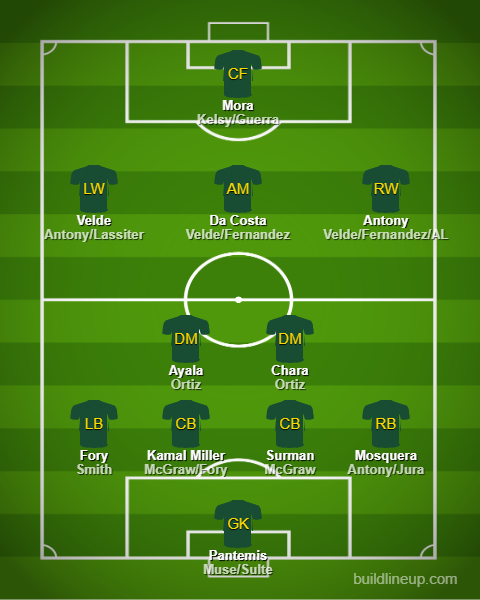
This is Portland’s best XI based on current roster status. In his end-of-season press conference, Phil Neville said the following: “We’re a 4-2-3-1 team that wants to score goals, entertain, and play fast attacking football.” So this is how the squad planning will go for next year. They want to play in a 4-2-3-1, so they have to assess their depth with that structure in mind.
Two positions jump out immediately: center back and central midfield.
Center Back
This positional need can be filled in free agency. Every team should have four genuine center backs. Fory and Smith can technically play there, but they’re both left backs first and foremost. Finding a dependable solid backup for Miller and Surman (who are unquestionably at the top of the depth chart) will be key. Allowing Miller and Surman to cement themselves as the first-choice pairing will provide stability. There’s no need to mess with that, particularly after Miller’s strong end to the season.
Central Midfield
Ayala enters the season as the unquestioned starter. But the spot next to him is technically up for grabs. I don’t think the coaching staff has a lot of faith in Joao Ortiz. He didn’t play a single minute of the San Diego series and didn’t even travel for Game 3. However, there is a world where he can establish himself as the 8 in Portland’s double pivot. I could also see him as a 6 in the 4-3-3 look they used in Game 2. But the departure of Paredes means that the Timbers absolutely need to find another central midfielder.
This is the best position to find a U22 Initiative player. I expect Ortiz to be a TAM player next year after the team used a fair amount of GAM to make his cap hit compliant in 2025. The Timbers can try to find a U22 to fill a squad player role in 2026 and work his way into being a starter in the future. However, because next year is the final year of Neville’s contract, it also makes sense to sign a TAM central midfielder who can be an unquestioned starter. I’m still grieving Carballo’s torn ACL. He really was the chosen one.
Right Wing
This position doesn’t jump off the page like center back and central midfield. But it is worth noting another one of Neville’s end-of-season comments: “A big, big point of playing 4-2-3-1 in our system was Santi Moreno.”
When Rodriguez returns in July, the roster will become very tilted. The Timbers will have 3 starting-quality left wingers between Rodriguez, Velde, and Antony. I think Velde is the best player to start at that spot at the beginning of 2026. So what does that mean for the opposite flank?

This is what Portland’s 4-2-3-1 looks like in possession. Mosquera’s ability to provide width forces the right winger to invert. I don’t think Antony is the best choice for that role unless he works on his game to be more effective in the channels. Right now, he’s very good at providing width. But the nuances of playing that position (better off-ball movement to open space) make Portland’s right winger into a channel threat instead of a width-holder. A boiling hot take is to move Da Costa to that spot. But Da Costa’s all-around progression abilities would be wasted if he’s disconnected from the pivot in such a fashion. Omir Fernandez could be a candidate for that role. His biggest strength is his off-ball movement. Could a Fernandez/Mosquera partnership on the right side be as effective as the Moreno/Mosquera tandem?
I don’t think so, but it wouldn’t hurt to try it out. Fernandez arrived in Portland with a nerfed cap hit (thank you Colorado) but the Timbers will now be responsible for making his $662K salary work with next year’s roster. A signing in this area of the pitch is likely. But Velde could be utilized in this role too. I think this is a position to wait on. A signing isn’t immediately needed, but the coaching staff needs to try and solve this problem.
One solution could be free agent Cristian Espinoza. However, his price tag would probably necessitate a DP deal. The Timbers cannot afford to add a DP to the team given their current contract commitments. But it wouldn’t hurt to do some good old-fashioned due diligence.
Right Back
Sawyer Jura will join the first team in 2026. That’s really cool. But is it too much to expect him to be Mosquera’s immediate backup?
Right back is the most specialized role in Portland’s system because it is built specifically for Mosquera. That’s why I’ve plugged Antony into the right back depth chart. I think he can be an adequate replacement if absolutely necessary.
Striker
Mora and Kelsy will compete for the starting job, but don’t discount Guerra. These are the abilities that a good striker needs: knowledge of where the goal is, ability to find space in the box, and finishing. I think Guerra has all three. Given his incredibly team-friendly contract, it wouldn’t hurt to give him playing time as a center forward. If Mora’s option wasn’t exercised, I’d be fine with a Kelsy/Guerra striker room in 2026. There’s also the possibility of Rodriguez moving centrally after he returns to the team. Striker is not a position to worry about during the offseason.
Final Whistle
I needed some time to digest this season before delving into the offseason. There’s no doubt that the Timbers are in a better place this year than they were last year. But there’s a big question hanging over the organization during this offseason: is that “better place” on par with being a perennial trophy contender?
I think that the majority of the pieces are in place for that to become a reality. Aside from central midfield, I don’t think any new starters need to be added in the offseason. There’s always a need for depth too.
2026 is a big year. It’s the final season of Neville’s contract, and he’s going to have to do something big to earn a second deal: elevate.
2024 was his first year, and he just had to put the correct pieces in place and let them work. 2025 saw the team get molded into the squad that he wanted. That squad, through various bouts of inconsistency and injuries, overachieved based on the Underlying Numbers. Now it’s time for his biggest test: taking the team that he has built (with Grabavoy’s help) and mold it into something bigger than its parts.
The through-line for the 2025 season (from my end) was their out-of-possession structure. Entering 2026, finding a solution for that problem is still the easiest way to make this team harder to beat on a consistent basis. That’s where the bar is still at; becoming harder to beat. It’s the baseline that I was hoping would be established in 2025. Finding ways to win games is much easier when there’s a tangible base to build on. With the addition of a new central midfielder, their spine should be complete.
The elevation of this squad from the inconsistency of 2024 and 2025 into a complete unit that can consistently compete on the highest level is a daunting task. However, it can be achieved. Whether or not it does will dictate Neville’s future with the club. That’s not an outrageous suggestion by any means.
David Da Costa will undergo shoulder surgery soon. After scoring a wonderful goal against Atletico de San Luis, his shoulder suddenly became a ticking time bomb. It would “pop out” frequently, and he gutted through the pain and played the remainder of the season. He’s expected to be ready by the season opener, per Ned Grabavoy. Portland’s fortunes in 2026 already rested on Portuguese Dave’s metaphorical shoulders, now they rest on his actual ones too.
This unique offseason will be light on drama. That’s a welcome relief. February 21st is exactly three months away. There’s a lot of work to be done between now and then. I think the team’s rebuild is complete. This is no longer Giovanni Savarese’s squad. If they’re still intent on trying to get to the mountaintop, there’s a lot of climbing to go. Elevation cannot be gained by standing still. The climb continues.

